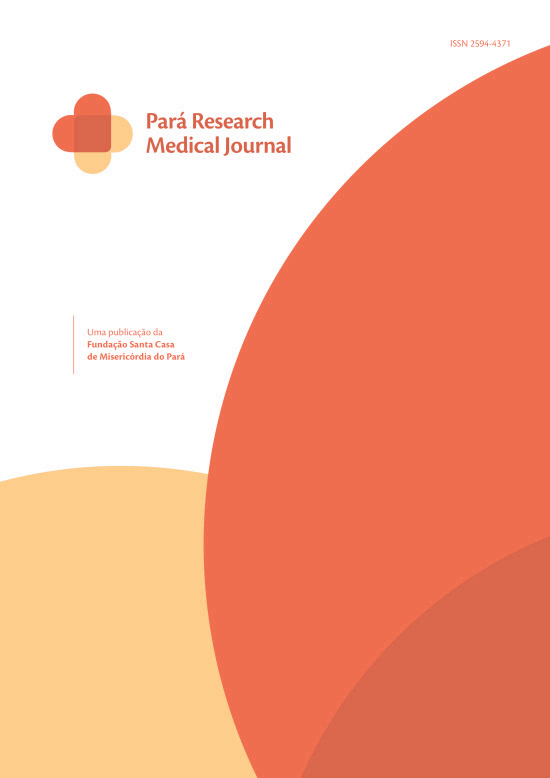A historical series of the incidence of Tuberculosis in Pará between 2015 to 2019
DOI:
https://doi.org/10.5327/prmj.2022.007Keywords:
tuberculosis, primary health care, epidemiologyAbstract
Purpose: Demonstrate the incidence of tuberculosis in the period from 2015 to 2019 in the State of Pará and to describe the epidemiological profile of the patients analyzed. Methods: This is a descriptive epidemiological study, in the type of historical series, that used the databases SINAN. Results: Between 2015 and 2019, 23064 cases of tuberculosis were reported and with an increase in the number of diagnoses over that period. Most cases were in men (66%). The most frequent age group was 20−29 years old (26.6%), and patients classified as brown were the most affected (74.7%). The incidence of tuberculosis was higher in patients with schooling between the 5th and 8th grades of elementary school (17%). An increase was also noticed in the notification of cases in patients living with human immunodeficiency virus, smokers and in the population deprived of liberty. Conclusion: It is noticed that Tuberculosis is still a problem with a high and growing incidence in the State of Pará. It is necessary to invest in quality primary care so that there are more early diagnoses in order for the treatment to be effective and thus the chain transmission can be interrupted. Investments are also needed for socioeconomic changes, encompassing both basic sanitation problems and infrastructure changes in the Brazilian prison system.
Downloads
References
World Health Organization Global. Tuberculosis Report 2020. Genebra: World Health Organization; 2020.
Brasil. Boletim Epidemiológico – Tuberculose 2020 [Internet]. 2020 [acessado em 29 jan. 2022]. Disponível em: https://www.saude.gov.br/images/pdf/2020/marco/24/Boletim-tuberculose2020-marcas--1-.pdf.
Kozakevich GV, Silva RM. Tuberculose: revisão de literatura. Arq Catarin Med [Internet]. 2016;44(4):34-47.
Brasil. Manual de recomendações para o controle da tuberculose no Brasil 2019. [Internet]. 2019 [acessado em 29 jan. 2022]. Disponível em: https://bvsms.saude.gov.br/bvs/publicacoes/manual_recomendacoes_controle_tuberculose_brasil_2_ed.pdf
Silva DR, Rabahi MF, Sant'Anna CC, Silva-Junior JLRD, Capone D, Bombarda S, et al. Diagnosis of tuberculosis: a consensus statement from the Brazilian Thoracic Association. J Bras Pneumol. 2021;47(2):e20210054. https://doi.org/10.36416/1806-3756/e20210054
Rodrigues MW, Mello AGNC. Tuberculose e escolaridade: uma revisão da literatura. RIAI [Internet]. 2018;4(2):1-12. https://doi.org/10.17561/riai.v4.n2.1
San Pedro A, Oliveira RM. Tuberculose e indicadores socioeconômicos: revisão sistemática da literatura. Rev Panam Salud Publica. 2013;33(4):294-301. https://doi.org/10.1590/s1020-49892013000400009
Silva LR, Visgueira AF, Oliveira NL, Rocha MEMO. Variáveis epidemiológicas da infecção pelo HIV em gestantes. Rev Enferm UFPI. 2016;5(1):34-9.
Massabni AC, Bonini EH. Tuberculose: história e evolução dos tratamentos da doença. RBM [Internet]. 2019;22(2):6-34. https://doi.org/10.25061/2527-2675/ReBraM/2019.v22i2.678
Pereira LFS, Maués CRF, Carvalho AJS, Lima AS, Bezerra NV. Epidemiologia da tuberculose no estado do Pará. Braz J Hea Rev. 2019;2(2):800-8.
Belo MTCT, Luiz RR, Hanson C, Selig L, Teixeira EG, Chalfoun T, Trajman A. Tuberculose e gênero em um município prioritário no estado do Rio de Janeiro. J Bras Pneumol. 2010;36(5):621-5. https://doi.org/10.1590/S1806-37132010000500015
Holmes CB, Hausler H, Nunn P. A review of sex differences in the epidemiology of tuberculosis. Int J Tuberc Lung Dis. 1998;2(2):96-104. PMID: 9562118
Basta PC, Marques M, Oliveira RL, Cunha EA, Resendes AP, Souza-Santos R. Desigualdades sociais e tuberculose: análise segundo raça/cor, Mato Grosso do Sul. Rev Saúde Pública. 2013;47(5):854-64. https://doi.org/10.1590/s0034-8910.2013047004628
Castelo Filho A, Kritski AL, Barreto AW, Lemos ACM, Ruffino Netto A, Guimarães CA, et al. II Consenso Brasileiro de Tuberculose: diretrizes brasileiras para tuberculose 2004. J Bras Pneumol. 2004;30(Supl 1):57-86. https://doi.org/10.1590/S1806-37132004000700002
Jamal LF, Moherdaui F. Tuberculose e infecção pelo HIV no Brasil: magnitude do problema e estratégias para o controle. Rev Saúde Pública. 2007;41(Supl. 1):104-10. https://doi.org/10.1590/S0034-89102007000800014
Santoro-Lopes G, de Pinho AM, Harrison LH, Schechter M. Reduced risk of tuberculosis among Brazilian patients with advanced human immunodeficiency virus infection treated with highly active antiretroviral therapy. Clin Infect Dis. 2002;34(4):543-6. https://doi.org/10.1086/338641
van Zyl Smit RN, Pai M, Yew WW, Leung CC, Zumla A, Bateman ED, et al. Global lung health: the colliding epidemics of tuberculosis, tobacco smoking, HIV and COPD. Eur Respir J. 2010;35(1):27-33. https://doi.org/10.1183/09031936.00072909
Wen CP, Chan TC, Chan HT, Tsai MK, Cheng TY, Tsai SP. The reduction of tuberculosis risks by smoking cessation. BMC Infect Dis. 2010;10:156. https://doi.org/10.1186/1471-2334-10-156
Diuana V, Lhuilier D, Sánchez AR, Amado G, Araújo L, Duarte AM, et al. Saúde em prisões: representações e práticas dos agentes de segurança penitenciária no Rio de Janeiro, Brasil. Cad Saúde Pública. 2008;24(8):1887-96. https://doi.org/10.1590/s0102-311x2008000800017




